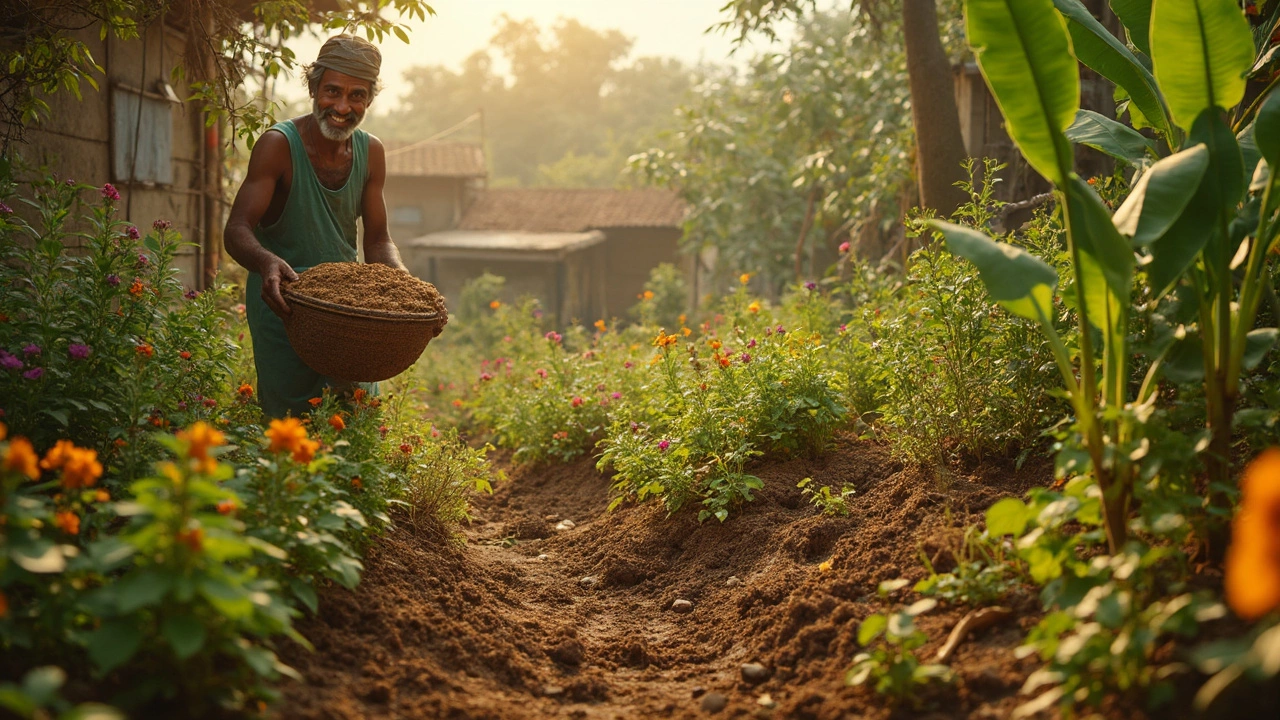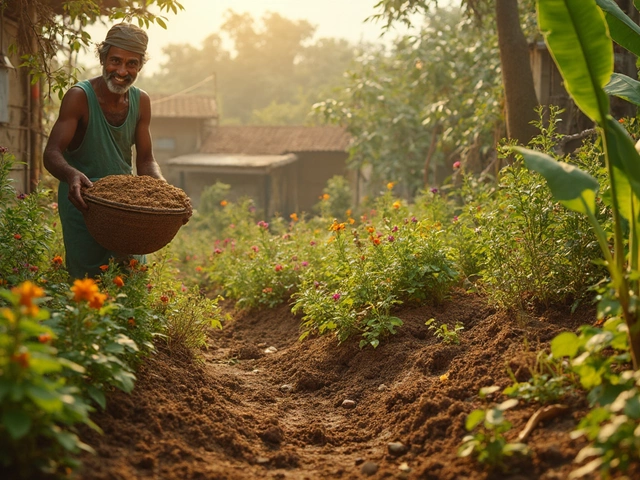Your garden can thrive without straining your wallet, and it starts with enriching the soil. Have you ever thought about transforming your kitchen scraps into a soil booster? Things like banana peels and coffee grounds, which you might be tempted to toss, can be a goldmine for your garden. It's like turning trash into treasure, helping those plants flourish.
But wait, there's more you can do! Budget-friendly composting isn't just about bags of store-bought compost. Setting up your own little compost corner at home can make a big difference. Just find an unused patch in your yard and let nature do its magic with your everyday waste.
- Understanding Soil Needs
- Using Kitchen Scraps
- DIY Composting on a Budget
- Power of Cover Crops
- Natural Amendments and Where to Find Them
- Recycling Yard Waste
Understanding Soil Needs
Before jumping into ways to fix up your soil, it's a good idea to really get what your garden needs. Different plants require different things, so knowing your soil's current state is the first step. Not all dirt is created equal—some might be sandy, while others are more like clay. Each type handles nutrients and water differently.
Testing your garden soil can offer a lot of insight. Simple soil test kits are like garden whisperers. They'll tell you if you're lacking certain nutrients or if the pH balance is off. When those tests show you're low on nutrients, it doesn’t mean you have to splurge on expensive solutions.
A quote from Emma Johnson, a well-known gardening expert, puts it perfectly:
"Soil quality isn’t about having perfect dirt; it’s about understanding and improving what you've got."
Here’s a simple breakdown of what you might find and what to do about it:
- Sandy Soil: This soil drains water quickly and might not hold essential nutrients long enough—adding organic matter can do wonders here.
- Clay Soil: It retains water and nutrients but can be compacted easily. Loosening it up with compost or organic matter helps.
- Loamy Soil: Considered the best for gardening, it’s got a good mix of sand, silt, and clay and requires less intervention but still benefits from organic boosts.
Armed with this understanding, you'll make smarter choices about how to amend your soil without breaking the bank. Whether you go for cheap soil improvement with compost or other natural amendments, it's all about understanding what your garden needs to thrive.
Using Kitchen Scraps
Tap into the potential of your kitchen waste to boost your garden without spending a dime. Before you throw away those banana peels, coffee grounds, or eggshells, consider their potential as powerful soil enhancers.
Banana peels, for example, are rich in potassium, an essential nutrient that promotes root growth. Just chop them up and bury them near your plants. Coffee grounds, on the other hand, are an excellent source of nitrogen. However, they're acidic, so if you've got some acid-loving plants like roses or blueberries, sprinkle them around for a healthy boost!
Eggshells add calcium to the soil, preventing issues like blossom end rot in tomatoes and peppers. It's simple—crush the shells and mix them into the soil.
- Save your scraps in a container for easy access, allowing you to contribute daily.
- Compost scraps in small batches by adding them directly to the soil or to your compost pile.
- Experiment with a mix of scraps to find what works best for your garden's needs.
Another tip? Citrus peels can be handy to deter pests. The strong smell of oranges and lemons keeps certain bugs at bay—just scatter them around plants you want to protect.
By tweaking what you already have at home, you not only save money but also give your plants a nutrient-rich environment to flourish. Plus, you get to reduce waste, making your garden green in more ways than one!
DIY Composting on a Budget
Composting doesn't have to burn a hole in your pocket. In fact, you can start a compost pile with stuff you already have lying around. It's all about using what you've got wisely. First, let's look at what makes a good compost pile. Your compost needs a mix of green materials, like fruit and veggie scraps, and brown materials, such as dried leaves or newspaper.
Setting up a DIY composting system is easier than you might think. You don't need fancy bins—some old pallets nailed together can create a perfect frame, or even a simple hole in the ground can do the trick. Just make sure you pick a spot with a bit of shade to keep the compost from drying out too quickly.
Here's a step-by-step guide to get you started:
- Start with a layer of branches or twigs to help with drainage.
- Add a mix of green and brown materials, alternating between the two for the best breakdown.
- Keep it moist, but not too wet. Think of a damp sponge when it comes to moisture levels.
- Turn the pile every couple of weeks to aerate it, speeding up the process.
- Be patient. In a few months, your compost will be ready to use.
If you’re worried about pesky smells, don't be. Bad odors are usually a sign of imbalance, easily fixed by adding more brown materials or turning the pile more often.
And hey, if critters get curious, just lay a tarp or cover over your pile. Remember, patience is key with composting—it's nature's way of recycling. With time, you'll have rich compost to boost your garden soil without spending a dime.

Power of Cover Crops
When looking to improve your soil without spending much, cover crops are like magic beans. They might not grow into a giant beanstalk, but they sure pack a punch for your garden's health. These are plants you grow primarily for the benefit of the soil, not for harvesting. You can think of them as a living blanket that protects and nourishes the ground.
So, how do they work their magic? Cover crops like clover, rye, and mustard are pros at fixing nitrogen into the soil. This means they naturally add nutrients which reduce the need for chemical fertilizers. Plus, they're your garden's personal bodyguard, suppressing weeds and preventing soil erosion.
Using cover crops is kind of like having a secret weapon. When it's time to clear them away, let the plants decompose right there in the soil. This process improves soil structure and fertility. It's just like nature's own way of composting, but right where you need it most.
If you're curious about what to plant and when, here's a quick guide:
- Spring/Summer: Opt for buckwheat or clover. They grow quickly and give your soil a nitrogen boost.
- Fall/Winter: Rye and vetch are favorites for colder months. They protect and enrich as they grow over winter.
Here's a little tidbit: According to a recent gardening survey, gardens with cover crops can achieve up to 20% more yield in their main crops. That's pretty impressive for something that doesn't require a trip to the garden center!
So, next time you're pondering how to get that soil just right, don't overlook the power of cover crops. They're affordable, effective, and one of the best friends your garden can have.
Natural Amendments and Where to Find Them
If you're on a quest to make your garden soil more fertile without spending a fortune, turning to natural amendments can be a game-changer. These earth-friendly boosters improve soil health and are often hiding in plain sight.
First up is bone meal. It's a fabulous source of phosphorus and can be found at gardening stores or even online. But if you live near poultry farms or know a butcher, they might have some to spare for cheap or free.
Then there's fish emulsion, which smells like a beach day gone wrong but does wonders for your plants with its rich nitrogen content. You might find it at fish markets or places that specialize in fishing supplies. It's a magical potion, especially for leafy greens.
Another sneaky amendment is eggshells. Next time you make scrambled eggs, save those shells. Crushed fine, they're a brilliant source of calcium, which helps prevent blossom end rot in tomatoes and peppers. Just wash, dry, crush, and sprinkle around your plants.
For those dealing with acidic soil, wood ash from a fireplace or barbecue can help balance the pH. It's easily accessible if you or any of your neighbors use wood burning stoves or have bonfires.
Lastly, leaf mold is like nature's gift to your garden. When leaves decompose, they transform into a superb soil conditioner. If you're raking leaves in the fall, don't bag them up. Instead, pile them in a corner and let time and rain do the rest. By spring, you'll have this fantastic, crumbly amendment ready to sprinkle around.
And if you're into numbers, here's how these amendments can benefit:
| Amendment | Main Nutrient | Application Rate (per square foot) |
|---|---|---|
| Bone Meal | Phosphorus | 2-3 tbsp |
| Fish Emulsion | Nitrogen | 2-3 tbsp diluted in water |
| Crushed Eggshells | Calcium | Scatter lightly |
| Wood Ash | Potassium | 1-2 cups |
| Leaf Mold | General Soil Conditioner | Spread 1-2 inches |
There you have it, a treasure trove of knowledge to enrich your garden without emptying your pockets. It's all about looking around and making the most of what's readily available. Your plants will thank you, and your wallet will too!
Recycling Yard Waste
Ever thought about the potential hiding in your yard's waste? Those piles of leaves, grass clippings, and twigs are not just rubbish—they're a hidden gem for enriching your garden soil. By recycling yard waste, you’re not just cutting down on trash but also putting valuable nutrients back into the ground.
Start by gathering your yard waste. Leaves are fantastic as a mulch layer. Spread them around plants and trees. They slowly decompose, providing nutrients and helping to retain moisture in the soil. It's as simple as raking them up and spreading them around.
Grass clippings are another easy win. Instead of bagging them up after mowing, leave them on the lawn or mix them into your compost pile. They're rich in nitrogen, an essential nutrient for plant growth. Just mix them with dry leaves or straw to balance moisture levels.
"By utilizing what's already in your backyard, you're participating in one of the most efficient forms of recycling," says Samantha Green, a well-known horticulturist, adding, "It's environmentally friendly and highly beneficial for soil enhancement."
And don’t forget those small branches and twigs. They can be shredded to make a coarse mulch or used in hugelkultur, a technique where logs and branches are buried to serve as a long-term water reservoir.
- Gather fallen leaves and use as mulch.
- Leave grass clippings on the lawn or compost them.
- Shred small branches for coarse mulch.
Here's a quick way to see the benefits of recycling yard waste:
| Yard Waste Type | Main Nutrient Provided | Use |
|---|---|---|
| Leaves | Carbon | Mulch |
| Grass Clippings | Nitrogen | Compost |
| Twigs and Branches | Carbon | Mulch or Hugelkultur |
So next time you're cleaning up the yard, remember: what looks like waste can actually boost your garden's success. Just start recycling, and watch the magic unfold in your backyard.




